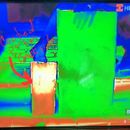K-value, spray cork, and thermographic readings
First time asking a question, but trying to wrap my brain around this:
Was looking into having spray cork applied over/to my 1940 brick exterior. The company (out of Canada) proclaims a low K-value and thus a thermal break benefit.
However, when the regional rep. came out I did a basic wing nut test letting his sample board (OSB coated in the product top half of one side) and another OSB scrap board of same thickness sit out in the east-facing morning sun for 20 minutes. Then, I broke out my thermographic camera (I am a certified thermographer) and was intrigued not to find that the coated portion had more heat present than any other board area…BUT, flipped over, the thermography showed the same footprint in the same area of the board — the heat transferred through to the backside of boarding and was 15-20 degrees warmer than uncoated OSB.
If this product is intended to act as a thermal break and thus improve the energy efficiency of a home’s wall assembly, why could I see more heat on the backside of the OSB in the coated area?
What am I missing? Or, is the product potentially not as well performing as advertised?
Greg in TN
GBA Detail Library
A collection of one thousand construction details organized by climate and house part










Replies
My first guess is the surfaces were different colors, with the cork coated surface probably darker and less reflective, so it heated up more in the sun. That “heated up more” was probably enough to overwhelm the slight increase in insulating ability the cork layer was provided, showing the result you’re seeing. The cork layer would also have helped to hold in any heat since insulation works both ways.
There was another thread here recently about this material and their made up claims of K value. You need R value to compare insulating materials. Their product will have an R value too, even if they’d rather state some other value they like better. Even if they haven’t tested their material for R value, someone else could. You then compare R values to compare relative thermal insulating abilities of different materials, and R value is R value, so the comparison is valid (assuming the same testing methodologies were used on all materials).
I’m sure the spray cork does help a little with insulation, but I doubt very much it really offers much, if any, difference in thermal performance compared to other insulating materials. Id be very surprised if a 1/2” layer of cork could outperform a 1/2” layer of polyiso or EPS, for example. The cork may have other benefits though, such as better resistance to exposure to sunlight (EPS will deteriorate if left exposed), so it probably has some value, but don’t expect it to be a miracle thermal insulating material.
Bill
Hey Bill,
Thanks for the perspective!
The company touts K-value b/c the application has no significant thickness and you need both K-value/factor and thickness to quantify R-value. BUT, they do claim that b/c the K-value is low it effectively creates a thermal break and thus reduces thermal bridging. However, thermographically at least, it would appear the heat did hold in the coated area more (as you said) and then transferred through the board. It's the transferring that has my guard up -- if it transfers through the material there can be no thermal break and, at least in my non-scientific review, would appear to increase heat transfer with darker coat coloring (it was a gun metal grey on his sample board). I just want people smarter than me to tell me what I am missing, or if I am correct. 😊😉
They could easily rate their product in R per inch, which is easy to calculate for any other material. The fact that they concentrate on a rating that is not commonly used is suspect, because the appearance is that they are trying to avoid their product being compared to others.
I wouldn’t draw too many conclusions from your simple thermal test, because I think there are a lot of uncontrolled variables (thickness of samples, color, exposure angle, probably other things too), making it not a valid test. I don’t want to just trash the cork product, either, it’s important to make accurate measurements here so that you know what you’re dealing with. I don’t think the cork product will outperform other insulating materials, but I do think it probably does add some insulating value compared with having no continuous insulation. The real question is if the cost of the cork product is justified for the level of performance it provides.
Bill
"proclaims a low K-value"
What value? And how thick was this coating? And how thick do you plan to use it?
R-value = thickness / K-value
Some quick googling finds a K value for spray cork of 0.068 but as high as .232
thus and R value of .5/.068 = 7.4 or .5/.232 = 2.15 As for your test having more heat because you were in the sun that starts bring in other questions about radiation vs conductive heat, thermal mass, thermal reflectance and so on. Either way splitting the difference an r value of 4.x isn't overly different so yea.
My bigger concern is brick is designed as a drying assembly. What is the vapor permeance of this material. And does it allow the brick to dry? If not your brick will deteriorate rapidly. Adding to this in Canada (assuming climate zone 6-8) an R-value of 4ish would likely put your condensing layer against the brick further accelerating decay
https://insulation.org/io/articles/k-value-u-value-r-value-c-value/